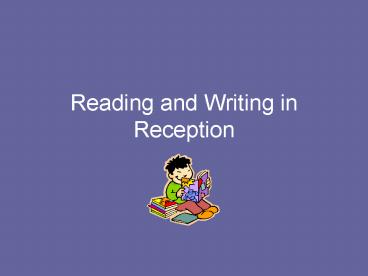Reading and Writing in Reception - PowerPoint PPT Presentation
1 / 12
Title:
Reading and Writing in Reception
Description:
Phonics Phonics is taught systematically following Letters and Sounds and we use Jolly Phonics and Big Cat phonics to deliver the programme. – PowerPoint PPT presentation
Number of Views:141
Avg rating:3.0/5.0
Title: Reading and Writing in Reception
1
Reading and Writing in Reception
2
Aims of this session
- To become familiar with how we start reading and
writing at school. - To understand what we mean by shared and guided
reading and writing. - To learn about how we teach phonics.
- To clarify what home / school reading means.
- To encourage a love of reading and writing for
our children.
3
How We Get Started - Reading
- Daily sharing of stories - this may be reading
Big books, home time stories, reading poems and
rhymes, exploring non fiction texts. - Continuous access to well stocked book corners
and author boxes. - Daily phonics teaching - including teaching
tricky words. - Choosing quality texts and offering a wide
variety of texts including poetry and
non-fiction. - Weekly storytelling sessions using a story cloak
and props. - Continuously making texts great fun and exciting!
4
Shared Reading
- Using Big books this enables us to model many
strategies that are needed to enable children to
decode words and make sense of the text. - Using other stories - quality texts are chosen to
build on enthusiasm and enjoyment.
5
Guided Reading
- This starts off in pairs before developing into a
group session. - A specific text is chosen to maximise the
learning for a particular group i.e. it targets
their needs. - The session is often started with some practise
of phonics and key vocabulary. - The children will follow their teacher as they
point to each word and use picture clues to
predict words. - They will practise blending and segmenting to
read. - They will also attempt to read on their own after
the initial teacher led reading, using the
repetition and key vocabulary in the book. - There will be time to discuss the
characters/events in the story or interesting
information in non-fiction books.
6
Independent Reading
- Children have daily access to reading corners in
their classroom which have a wide selection of
texts which we swap around regularly. - Author boxes - we have many author collections so
that children can become familiar with a
particular authors style of writing. - Children love to play read to themselves or
with a friend which helps to foster their
enjoyment of stories and non-fiction books.
7
Phonics
- Phonics is taught systematically following
Letters and Sounds and we use Jolly Phonics and
Big Cat phonics to deliver the programme. Both
are interactive schemes which involve the
children actively in their learning. - Children learn the 44 phonemes (or units of
sound) through songs and actions and then learn
to blend them to read and segment them to write. - We play lots of games and use puppets and other
resources to make the learning fun. - Letters and Sounds also delivers a tricky word
programme so that each week the children build up
a sight vocabulary which we practise regularly.
We put these words on our Word Wall so that the
children can refer to them at all times.
8
Home/school Reading
- Your child will bring home a graded reading book
with a colour sticker to read to / with you. - Your child may try to use a finger to point to
each word as they read and use picture clues to
work out some words. - They may also try to segment and blend some words
to read as we have practised at school. - Please write a a comment to respond to the
teachers comment in the reading diary. This
dialogue is important so that we know how your
child is progressing with their reading.
9
Shared Writing
- Whole class writing enables us to model
strategies that are needed to enable children to
segment words for spelling. - It reinforces how sounds in words are represented
using letters. - It begins to introduce children to sentence
structure, capital letters and full stops.
10
Guided Writing
- This starts off in pairs before developing into a
small group session. - Writing is based around a familiar text.
- Talk for writing is used to develop childrens
confidence in writing and provide a clear
structure. - Children are encouraged to say the word slowly,
hear the sounds and write the letters that
represent the sounds. - Alphabet/phonic mats help with identifying and
forming the letters.
11
Independent Writing
- Children begin to write using gross motor
movements which become refined as the they
develop their hand-eye co-ordination and fine
motor skills. - Opportunities to strengthen hand muscles and
pincer grip are provided on a daily basis. - Children have daily access to writing activities
in their classroom which have a wide variety of
purposes for mark-making. - Marks can be made using anything from pens to
fingers in shaving foam get creative!
12
Thank you
- Many of your children have already come to school
with a love of books and mark making - this makes
our job much easier! - Keep up the good work please read to and with
your child any time or anywhere - in bed, in the
car, in the bath! - HAPPY READING
- AND
- WRITING!































